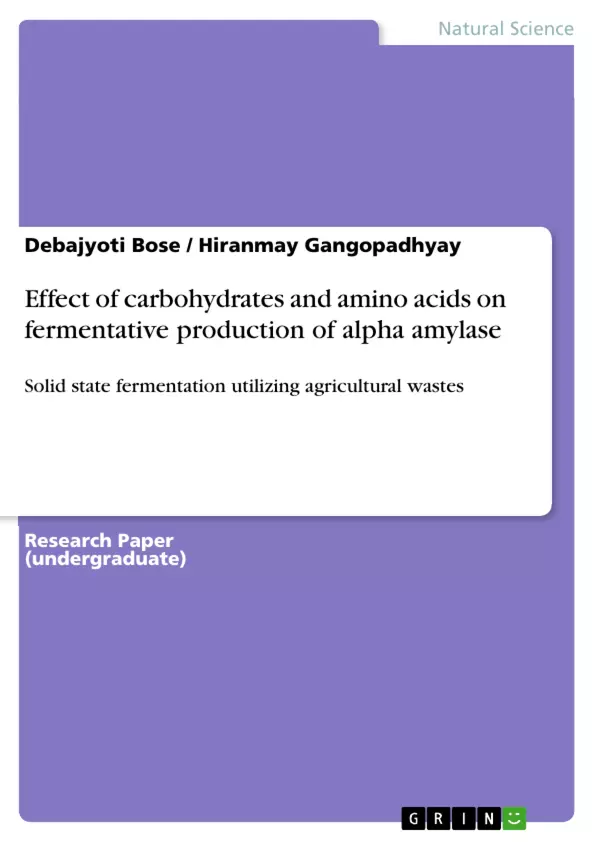Extracellular alpha amylase was produced from Aspergillus oryzae under solid state fermentation. House hold agro-wastes were used as medium which were considered as one of the major pollutants due to unfavorable gas production via natural fermentation beside creating disposal problem. Investigations were carried out to evaluate the effect of various carbohydrate sources e.g. glucose, maltose, lactose, sucrose and soluble starch with different concentrations on the production of fungal alpha amylase utilizing agricultural wastes as the fermentation medium. Studies were also carried out to evaluate the effect of various heat stable amino acids e.g. glycine, histidine, proline, leucine and isoleucine with different concentrations on the production of fungal alpha amylase utilizing agricultural wastes as the fermentation medium. The results indicated that maximum activity of alpha amylase (6639.85 U/gds) was obtained at 0.5% concentration of sucrose solution with a r2 of 0.9692 when compared to control (3319.95 U/gds) and other carbohydrates used. Maximum activity of alpha amylase (10407.80 U/gds) was also obtained at 0.75% concentration of proline solution with an r2 of 0.6816 when compared to control (3035.60 U/gds) and other amino acids used in our present study.
Inhaltsverzeichnis (Table of Contents)
- Introduction
- Materials & Methods
- Microorganism
- Utilization of agricultural wastes for SSF
- Preparation of Carbohydrate Solutions
- Preparation of amino acid Solutions
- Production of alpha amylase by SSF
- Results & Discussion
- Conclusion
Zielsetzung und Themenschwerpunkte (Objectives and Key Themes)
This study investigates the optimization of alpha amylase production from Aspergillus oryzae under solid-state fermentation (SSF) conditions using agricultural wastes as a substrate. The research aims to identify the optimal concentrations of carbohydrates and amino acids for enhancing alpha amylase production, potentially contributing to sustainable and environmentally friendly bioconversion processes.
- Production of alpha amylase by Aspergillus oryzae through SSF
- Utilization of agricultural waste as a fermentation medium
- Influence of different carbohydrates on enzyme production
- Effect of various amino acids on alpha amylase synthesis
- Optimizing conditions for maximizing alpha amylase activity
Zusammenfassung der Kapitel (Chapter Summaries)
The introduction provides background information on alpha amylase, its importance in various industries, and its production by different organisms. It discusses the use of agricultural waste as a substrate for SSF and its advantages compared to submerged fermentation. The study focuses on exploring the effects of various carbohydrates and amino acids on alpha amylase production by Aspergillus oryzae.
The materials and methods section details the experimental procedures including the microorganism used, the preparation of the agricultural waste substrate, and the preparation of carbohydrate and amino acid solutions. The methods for producing alpha amylase by SSF using Roux bottles are described.
Schlüsselwörter (Keywords)
The research focuses on alpha amylase production, solid-state fermentation, Aspergillus oryzae, agricultural waste, carbohydrates, amino acids, and bioconversion. The study explores the optimization of alpha amylase production by investigating the effects of different carbon and nitrogen sources.
- Quote paper
- Debajyoti Bose (Author), Hiranmay Gangopadhyay (Author), 2012, Effect of carbohydrates and amino acids on fermentative production of alpha amylase, Munich, GRIN Verlag, https://www.hausarbeiten.de/document/203837


